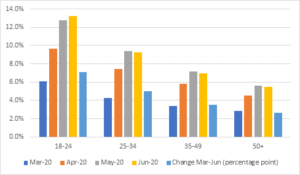Why the ONS employment figures show young people are slipping through the net
Jul 16, 20
We know the Covid-19 pandemic has impacted heavily on the UK economy – particularly sectors such as hospitality, retail and the creative industries. Some businesses may have started to open tentatively, but theatres and music venues, for example, have no indication of when they might resume business. We know that these are the sectors that young people under 25 are more likely to work in – making them much more likely to have seen their employment paused or ceased during lockdown.[1]
In the light of this bleak picture, the results of the latest employment survey released by the Office for National Statistics (ONS) today are slightly surprising. UK unemployment rate is estimated at 3.9%, 0.1 percentage points higher than a year earlier, but largely unchanged compared with the previous quarter.
We might welcome this as good news, however, the data shows a mixed picture. The latest figures to June show that approximately 650,000 people were removed from UK payrolls and while many have retained their jobs via the furlough scheme, as that support draws to a close many employers are expected to shed staff. A British Chambers of Commerce survey, also released today, found that 29% of businesses are expected to decrease the size of their workforce in the next three months.
Look a little closer and the figures for young people, aged 18 to 24 years, are even less positive. The number of claimants in this age group rose by around 30,000 this last quarter. This raises the claimant count in that age group to 540,000, but evidence suggests that the number of young people not in full time education, employment or training (NEET) – including those who are not ‘actively looking for work’ – is actually over one million.
.
We can see that young people are represented within the claimant numbers at an increasingly higher rate compared to other age groups – despite it being well documented that young people are less likely to claim unemployment benefits than their older counterparts. We know that young people are less likely to apply for benefits for a whole raft of reasons. Alex Morawski is a 22-year old graduate living in Barnsley who has been looking for a job for the past year, but hasn’t claimed Universal Credit. He says:
“There were multiple reasons I didn’t apply. I felt like I didn’t need to rely on it as I had savings and would feel guilty. Also I felt like not being on it would push me to get a job faster and one was around the corner. I did a calculator online to see how much I would get and it said I would qualify for nothing. The JSA process was long and I didn’t want to be forced into a job that I wouldn’t like and leave soon after.”
Before the outbreak, some 400,000 of the 750,000 young people who were classed as ‘NEET’ were not in receipt of benefits – and we know a significant proportion were classed as ‘disadvantaged’. The welcome £2bn ‘kickstart’ scheme announced by the chancellor last week, will subsidise six-month work placements for people on Universal Credit aged between 16 and 24, but it remains to be seen whether young people not in receipt of benefits will be eligible for the scheme.
Evidence shows that augmenting the Job Centre Plus offer with targeted outreach to young people has been successful in helping those furthest from the job market into work.[2] Establishing integrated and well-funded co-located employment and support services for young people across the country could help to ensure no young person is left behind.
The government has listened and responded to the concerns expressed by ourselves and our partners in the Youth Employment Group for those young people furthest from the job market, and we look forward to continuing constructive discussions. We hope that further government youth employment initiatives take account of and support the many young people not recognised within ‘the system’, many of whom face multiple barriers into the labour market.
Chief Executive of Youth Futures Foundation, Anna Smee, commented:
‘Sadly the figure of 540,000 18 to 24 year-olds registered as unemployed does not tell the whole story. Young people are less likely to apply for benefits when they exit the labour market suggesting the number of those not in education, employment or training (NEET) is actually over one million.
‘Young people receiving Universal Credit will be eligible for the very welcome Kickstart scheme announced by the chancellor last week, but those who are not receiving benefits are at risk of being unable to access support into training or jobs. There is evidence[1] that augmenting the Job Centre Plus offer with targeted outreach to young people has been successful in helping those furthest from the job market into work.
‘The government has listened and is responding to our concerns for the most disadvantaged youngsters who struggle most to make the transition into employment. We hope to continue to work with government to identify proven interventions which can ensure that young people who face disadvantage, disability or discrimination are not left behind.’
[1] https://www.ifs.org.uk/publications/14791
[2]https://learningandwork.org.uk/wp-content/uploads/2020/04/MyGo-Evalulation-Final-report-summary-September-2018.pdfr-2018.pdf